Chateau de Versailles also called the Palace of Versailles is one of the grandest palaces in France built during the Renaissance by Louis XIV. Read this detailed guide from Talk Travel App for travel tips and enjoy Versailles like a local.
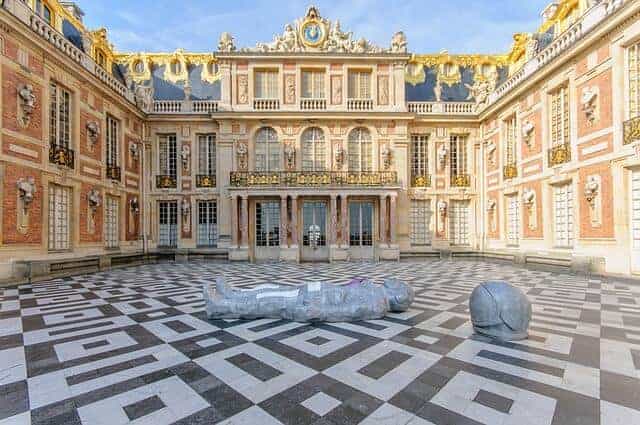
UNESCO designated the Palace of Versailles and its Garden as a World Heritage site in 1979. This opulent estate welcomes more than 7 million visitors every year. Versailles makes for a perfect one-day travel destination when you are visiting Paris.
Where is Chateau de Versailles located?
The Chateau de Versailles is located in the city of Versailles, Yvelines département, Île-de-France région, northern France, 10 miles (16 km) west-southwest of Paris.
How is the weather like at Versailles?
| Month | High / Low (°C) | High / Low (°F) |
| January | 6° / 2° | 42.8° / 35.6° |
| February | 8° / 2° | 46.4° / 35.6° |
| March | 12° / 4° | 53.6° / 39.2° |
| April | 15° / 5° | 59° / 41° |
| May | 19° / 9° | 66.2° / 48.2° |
| June | 22° / 12° | 71.6° / 53.6° |
| July | 25° / 14° | 77° / 57.2° |
| August | 25° / 14° | 77° / 57.2° |
| September | 21° / 11° | 69.8° / 51.8° |
| October | 16° / 8° | 60.8° / 46.4° |
| November | 10° / 4° | 50° / 39.2° |
| December | 7° / 2° | 44.6° / 35.6° |
Visiting Versailles is mostly an outdoor activity except of course when you are inside the Royal Palace. The charm of this Chateau lies in the gardens. You will have to be outdoors for a few hours, so please check the weather condition before you head to Versailles. You can always carry an umbrella or a raincoat just in case.
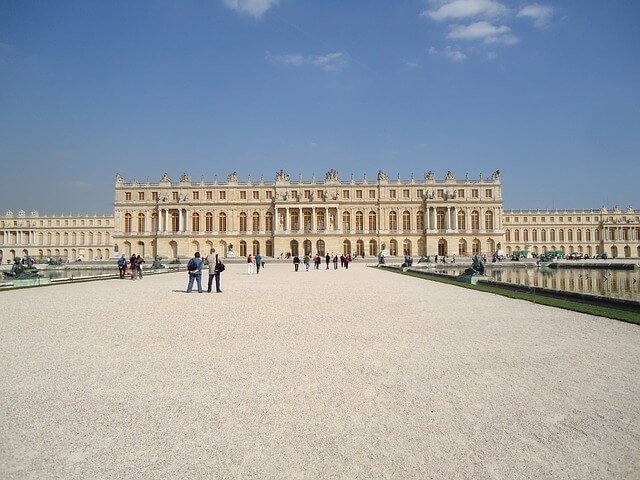
When is the best time to visit Chateau de Versailles?
Versailles has visitors all year round and the Chateau de Versailles is open throughout the year except on all Mondays of the year along with the 25th of December, 1st of January and 1st of May.
Peak months to travel are spring and summer between March to August. Please note that summer months between June and August are the busiest with a lot of visitors. The heat can be quite unbearable, so during summers come early at 8 am and explore the garden. During mid-day, you can explore the interiors of the Palace to escape the heat.
The months from November to February witnesses the least number of crowds which is advantageous. Note that the temperatures are very cold this time of the year, so keep yourself warm as the wind in the open expanse of the Garden can give you the chills.
When is the best day to visit Chateau de Versailles?
The first Sunday of every month from November to March has free admission to the Palace which means it can get crowded. Try coming early at 8 am to enter the premises soon to have a great time.
Chateau de Versailles is closed on Mondays but the brilliantly manicured Garden is open every day of the year. If you are short on budget, then visiting on Monday should be a good idea. You can marvel at the grandeur of the Palace from the outside and walk in the expansive and well-maintained Garden for free.
The best day to visit the Palace of Versailles is during the week as it has thinner crowds, especially on Wednesday and Thursday.
How to go to Chateau de Versailles?
Versailles is just 20 km from Paris and very well connected by public transportation like bus and train.
| Mode of Transport from Paris | Duration (One – way journey) | Cost (To and fro) |
| RER train line C | 1-hour | € 8 |
| SNCF Transilien – N Train | 15 minutes | € 6 |
| Uber | 1-hour | € 60 – 80 |
| Regular taxi | 1-hour | € 100 |
| Bus | 1-hour | € 10 |
| Bike | 1-hour | € 74 (€ 1000 deposit which will be returned) |
All prices mentioned in the above table are valid as of June 2018.
Travel Tip: Please carry cash when you want to buy tickets at the bus or train stations as international credit cards might not work. Carry light change or coins as it is impractical to render change for € 50 currency when your train/bus journey costs only €6.
By train:
From the Eiffel Tower metro station as a reference point to begin your journey from Paris to Versailles, you can take the RER train line C. Read this detailed guide to understand how to reach Versailles by train. At the metro station, go to the ticket counter and buy to and fro tickets to Chateau Versailles. The destination terminus station is called Versailles-Rive Gauche platform.
A one-way journey costs € 3.65. Follow the overhead and wall signs to reach the platform where the RER Line C stops. Get off at Versailles-Rive Gauche platform and then Chateau de Versailles is just 5 minutes by foot.
If you are residing in the southwestern part of Paris, then you can head to Montparnasse station to take the SNCF train to Versailles-Chantiers station. It costs € 6 for a to and fro journey and it will take less than 30 minutes to reach. Once you alight from the train at Versailles-Chantiers station, you have to walk for 15 minutes to reach the Palace of Versailles. You will find more information about train journeys here. You can book your train ticket directly on the SNCF website.
By car:
You have the choice of taking a cab like Uber or a regular taxi. The duration of the journey is one hour one way. Uber will cost you € 30 – 40 one-way and it is obviously very convenient to travel. A regular taxi will cost you up to € 50 for a one-way ride.
By bus:
You can take bus number 171 from the metro stop Pont de Sèvres, on line 9. Get off at the bus stop Versailles-Place d’Armes. A to and fro ticket will cost you around €10.
The Versailles Express is an exclusive bus service between Paris and Versailles. They offer packages at varying prices and timings. Have a look at their offerings and book a service that is convenient to you.
On bike:
If you are the adventurous type and would like to reach Versailles on a Vespa, then go for it! You will be riding along the Seine River, pass through typical French villages and some amazing landscape. Find out more details on the website of Paris by Scooter.
Is Château de Versailles disable friendly?
Absolutely!
The Chateau de Versailles is on a flat surface and easily accessible by wheelchair. All the restrooms are disabled friendly except in the Gabriel Pavilion and picnic areas. Rest are all accessible for disabled persons unless indicated otherwise.
Wheelchairs are available in the Palace of Versailles and the Grand Trianon. People who use walking sticks or crutches can leave them at the Left Luggage desk and borrow a wheelchair to visit the site in greater comfort. There are lifts leading to the different floors of the Palace, allowing access to the whole State Apartments.
Please note that you need to retrieve your personal belongings before you visit the gardens because once you have left you cannot re-enter. To get back to left luggage after you have left, you must go through security and ticket checks once again.
Read this travel blog by Sage Traveling who have detailed their experience at the Palace of Versailles on a wheelchair.
There are a lot of benefits that can be availed upon showing a valid government approved disability card while purchasing tickets. There are different benefits while traveling solo or in groups, read further to know more:
| Type of tour | Entry Fee | What can you visit | Slots |
| Self-guided tour
| Free | In the Palace you can visit the King’s Apartments, the Queen’s Apartments, Hall of Mirrors, Coach gallery, and exhibitions. In the Estate of Trianon, you can visit The Grand Trianon, the Petit Trianon, and their gardens, as well as the Queen’s Hamlet | For the Palace, slots are available on all days except Mondays at 11h50, 13h05 and 14h only
|
| Guided tour Book 3 months in advance | €25 for 2 hours for each tour |
| Refer this calendar to see which guided tour is planned for which day before booking your tickets. |
| Discovery Tour Book 3 months in advance | €25 for 2 hours | Garden at the Palace of Versailles This guided tour is unique as it is led by a visual artist or an actor who make it participative and playful to visually evoke a sense of creativity in the visiting group | Wednesdays, Thursdays or Fridays at 11:15 or 13:45 |
| A Monday at Versailles | €25 for 2 hours | Refer this calendar to see which guided tour is planned for which day before booking your tickets | |
| Free and discounted visits | Free |
| Free, except the days of Music Fountain Night and Musical Gardens, from the end of March to the end of October, most Tuesdays, Fridays and weekends |
Refer this calendar to see which guided tour is planned for which day before booking your tickets.
Booking slots according to the calendar can be confusing sometimes, so mail them for any queries.
Please note the following conditions before booking slots in the above-mentioned schemes:
– Reservations open 3 months before the desired date of visit, the first business day of the month, at 8:30. Example: for a visit in January 2018, the opening of reservations on October 1, 2018, at 8:30. Requests are processed in order of arrival.
– If the reservation request is accepted, a document will be sent by email to the applicant. To confirm the reservation, payment must be made within 15 days
– For guided tours, self-guided tours and discovery activities, the maximum number of people per group is:
- Visual impairment: 4 people with disabilities and 4 companions;
- Motor impairment: 4 people with disabilities and 4 companions;
- Hearing impairment: 20 accompanying persons understood;
- Mental disability: 20 accompanying persons understood
You can explore the Palace of Versailles in small electric vehicles, find out more about the price range here.
Also, check our guide on disabled people traveling to France, it will give you a bigger picture on all the things you need to know before traveling.
Tips for travelers traveling with infants: Pushchairs and baby carriers with a metal frame are not allowed in the Palace and should be left at the cloakroom. It is advisable to bring a sling or baby carrier without a metal frame.
Where to buy tickets?
As always recommended, please buy the tickets online and do not waste time standing in the queue. During summers, there are many visitors and the queue can extend beyond the gates of the Palace and the heat is unbearable.
This list explains who can avail free admission to the Palace of Versailles on presentation of proof. Here is a comprehensive list of activities that are grouped and priced accordingly to suit varying needs of visitors. You can choose the best-suited ticket based on your interests and budget. You can buy your tickets online here.
Where to access Chateau de Versailles?
The main entrance to the Palace of Versailles is through the Main Courtyard past the majestic golden gates. If you do not have a ticket upon arrival and are not eligible for free admission, go to the ticket office first, situated on the left in the Main Courtyard, and then to entrance A of the Palace.
If you have reserved your ticket online and have already printed it, or if you are eligible for free admission, go directly to entrance A of the Palace with your proof of identity or ticket.
To visit only the Estate of Trianon, which is open from 12.00 pm, go directly to the entrances of the Grand or the Petit Trianon where you will also find a ticket office.
A brief history of the Chateau de Versailles
Spread over 800 hectares, the Palace of Versailles built during the 17th century has transformed from a hunting lodge in 1624 to the seat of power in 1682. It eventually became a museum in the 19th century. The history of the Chateau can be best explained by understanding the influence each king exerted in Versailles between 1624 – 1789 and beyond.
Louis XIII
The history of this place dates back to 1624 when Louis XIII built a hunting lodge at Versailles. He fell in love with this place after his first hunting trip here. Between 1631 and 1634, this country residence was replaced by a stone and brick chateau under his orders.
Louis XIV
It was Louis XIII’s son, King Louis XIV who transformed Versailles for good which is demonstrated by the affinity he had towards Versailles. Louis XIV was known to love the outdoors and had a strong interest in architecture and construction.
The young King Louis XIV would visit Versailles on hunting trips and eventually inherited this chateau. In 1666, he commissioned major construction activities. Over 50 years, the Chateau of Versailles was built to become Europe’s largest chateau.
Louis XIV moved his government and the court to Versailles from Paris. From 1682 onwards, the Chateau of Versailles became the official royal residence and on 6 May 1682. Louis XIV was the longest reigning king in the history of France, ruling the land for 72 years.
Louis XV
Louis XIV died on September 1, 1715. Following his death, there were many quarrels within the royal family for power. Louis XIV’s grandson Louis XV became the king to rule between 1715-1774.
When King Louis XV moved to Versailles, he broke strict court etiquette and fitted out smaller apartments for more comfort and privacy. These are called Petit Appartement du Roi. At the end of Louis XV’s reign, he built the Royal Opera House in 1770.
Louis XVI
Louis XVI’s reign will forever be associated with the outbreak of the French Revolution and the end of Versailles’ royal era. Under his rule, Versailles seemed to look deserted due to the absence of the courtiers and the kingdom was beset with financial woes. Following a diamond necklace scandal involving his Queen Marie-Antoinette and her luxurious lifestyle led to growing distrust among the commoners.
French Revolution
Uncertainty started to loom in 1789 as there was a huge budget deficit. On the morning of 5 October 1789, the women of Versailles took to the streets protesting the high cost of living and scarcity of bread. The agitators laid siege to the palace and placed their demands in front of Louis XVI. The next day, the crowd compelled the king, his family to return with them to Paris. For the first time in history, the Palace of Versailles was deserted by the King and the Queen.
The 19th century
After the mob ransacked the Palace, it was still in good shape. When Louis-Philippe took power in 1830, the Versailles residents hoped it would be given a new purpose. Major restoration work took place in his era and it continued to host the most important events in the history of France. On 1 September 1833, the Citizen King decided to open a history museum in it dedicated to “All the glories of France”.
Versailles became the center of attention to the world when the Treaty of Versailles was signed here in the Hall of Mirrors in 1919.
The 20th century
As time passed, as gratitude for the involvement of France in the American War of Independence, an American billionaire, John D. Rockefeller donated funds for the restoration of Chateau of Versailles. The Palace’s curators took up refurbishing the rooms and the palace eventually regained its popularity.
Chateau de Versailles
The below image represents the layout of Palace of Versailles.
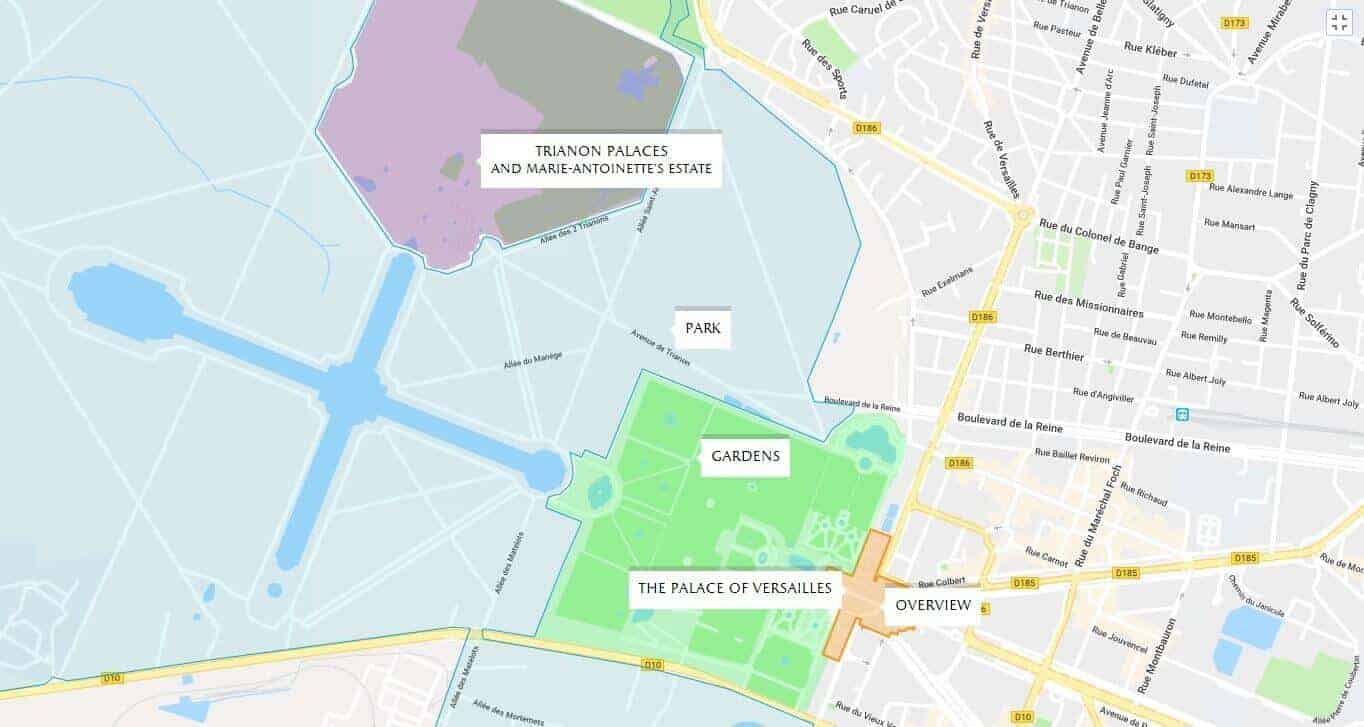
Here is a quick summary of the opening times and the best time to visit the Palace of Versailles:
| Days | Timings | Best time of the year to visit | |
| The Royal Palace* Minimum Visit Duration: 1-2 hours | All days except Monday, 25th of December, 1st of January & 1st of May
| 9 am to 6.30 pm during the high season (April to October) 9 am to 5.30 pm during the low season (November to March) | Any time of the year But your visit to the Palace should be at a time when you can enjoy the Gardens at the same time |
| Orange Garden Minimum Visit Duration: 30 minutes | All the days | 8 am to 8.30 pm during the high season (April to October) 8 am to 6 pm during the low season (November to March) | April to October All the citrus plants are out on display in the garden at this time |
| Gardens Minimum Visit Duration: 3-4 hours | All the days | 8 am to 8.30 pm during the high season (April to October) 8 am to 6 pm during the low season (November to March) | Any time of the year The garden looks colorful during spring and summer though, with flowers in full bloom |
| The Coach Gallery Minimum Visit Duration: 1 hour | All days except Mondays, 25th of December, 1st of January & 1st of May | 12.30 pm to 6.30 pm during the high season (April to October) 12.30 pm to 5.30 pm during the low season (November to March) | Any time of the year |
| Trianon Palaces Minimum Visit Duration: 3 hours | All days except Mondays, 25th of December, 1st of January & 1st of May | 12 pm to 6.30 pm during the high season (April to October) 12 pm to 5.30 pm during the low season (November to March) | Any time of the year |
| Fountains Night Show Minimum Visit Duration: 1 hour | Every Saturday from 16 June to 15 September 2018 from 8.30pm to 10.40pm and fireworks from 10.50pm to 11.05pm (water displays from 8.30pm to 10.45pm) Have a look at this Fountains Night Show calendar before planning your visit. | Find a nice spot near the Palace which faces the Grand Canal or near Latona’s fountain for spectacular views of the fireworks |
The Palace
Considered one of the most beautiful and largest palaces in Europe, the Palace of Versailles stands true to its word. You will be amazed by the grandeur of the Palace itself and the Garden surrounding it. The rich interiors of the Palace with its intricate design, expensive mirrors, silk drapes and busts of kings and queens speaks volumes of the opulence of those times. There are glorious paintings on the roofs boasting of French victory and every room in this Palace has historical significance. The first thing that beckons you at the Chateau de Versailles is the Equestrian Bronze Statue of Louis XIV at the entrance of the Palace of Versailles and the glittering golden gate.
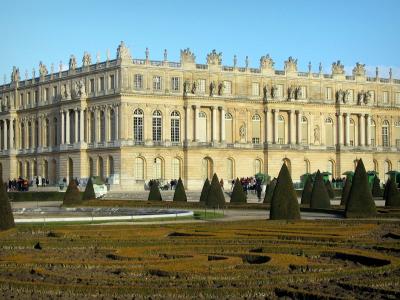
While you visit the King’s Apartments, Queen’s Apartments, Hall of Mirrors in the Palace, do not miss out on other important attractions like the Orangery, the War Room, the Peace Room and many more. Encompassing 67,000 square meters (721,182 sq ft) the palace has 700 rooms, more than 2,000 windows, 1,250 fireplaces and 67 staircases.
Watch this quick visual tour of the Palace of Versailles and its garden in this Versailles Vacation Travel Video Guide.
You can enjoy an audio guided tour of the Palace, the Hall of Mirrors, the King’s Apartments, the Royal Chapel, the Battles Gallery and more by downloading the Palace of Versailles app. It is available for Android and iOS phones and you do not need an internet connection to use the app.
King’s Apartments
The King’s Apartments has a stretch of rooms that lead to the King’s bedchamber. Like in all royal residences, the Guard Room marks the entrance to the King’s Apartments. The main King’s bedchamber is a large lavishly decorated room, situated in the center of the eastern façade of the Palace.
Queen’s Apartments
The layout of the Queen’s Apartments is identical to that of the King’s State Apartments to the north. The layout of the first floor of the Palace was perfectly symmetrical, with the north belonging to the king and the south to the queen. Read how the layout of the Queen’s Apartments changed with each queen in this travel blog. Under the Queen’s apartment was the apartment of the Grand Dauphin, the heir to the throne.
Marie-Antoinette’s private chambers
In Versailles, the queen had a series of small rooms beyond her State Apartments which were reserved for her personal use and for service by her ladies-in-waiting. Common during the times of royalty, the occupant residing in the Queen’s chamber would decorate the chamber as per their tastes and fancies.
Watch this video to see how opulent Marie Antoinette’s private chamber was and interesting stories about this chamber.
The Grand Gallery
The Grand Gallery is a set of three highly decorated reception rooms, dedicated to the celebration of the political and military successes of Louis XIV, and used for important ceremonies, celebrations, and receptions.
Hall of Mirrors
The Hall of Mirrors, known as The Galerie des Glaces in French, is the most famous room in the Palace. It was built to replace a large terrace that separated the King’s and Queen’s apartments. Jules Hardouin-Mansart, the chief architect of the Palace of Versailles designed the Hall of Mirrors starting from 1678 and ending in 1684. The gallery extends more than 230 feet (70 meters) and is characterized by 17 wide arcaded mirrors opposite the 17 windows that overlook the gardens below.
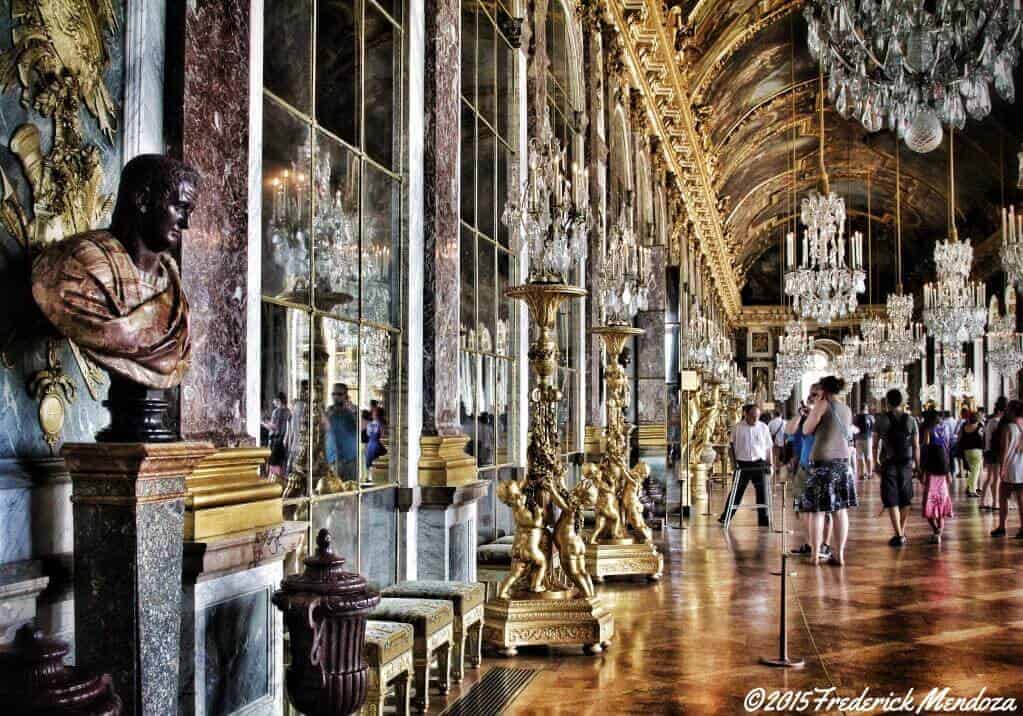
While the Hall is glorified for its beauty and the possession of mirrors which was an expensive item those days, read this interesting story about how the Venetians tried poisoning the mirror making artisans to prevent the French from stealing the mirror-making technique. The Venetians plotted this since mirrors were rare those days and they had the exclusive knowledge to make mirrors and hence was a great source of revenue from the exports.
Hall of Mirrors holds significant historical importance as the state of Germany was declared in 1871 and the Treaty of Versailles signed by the victorious powers of World War I in 1919.
Read this blog to know more about the Hall of Mirrors accompanied by fantastic pictures.
The War Room
The walls in the War Room are covered with marbles. The decoration pays tribute to the military victories which led to the peace treaties of Nijmegen which ended the Dutch War. A prominent feature of the War Room is the white oval stucco bas-relief which depicts King Louis XIV on horseback trampling his enemies.
The Peace Room
The Peace Room is symmetrical to the War Room and contains the same marble panel decoration. Marie Antoinette later converted the Peace Room into a games room and became a keen player of billiards and cards.
State Apartments
The State Apartments of the King were constructed between 1678 and 1686. During the day, the State Apartments were open to all who wished to see the king and the royal family passing through on their way to the chapel. During the reign of Louis XIV, evening gatherings were held here several times a week.
The Salon of Hercules / Hercules Room
The Hercules Room was the last room to be built by Louis XIV at the end of his reign. The Salon of Hercules was originally a chapel.
Work on the Hercules Room took four years to complete in the year 1736 when François Lemoyne finished the ceiling painting depicting The Apotheosis of Hercules. It was created by painting the scenes on canvas and then stuck onto the ceiling.
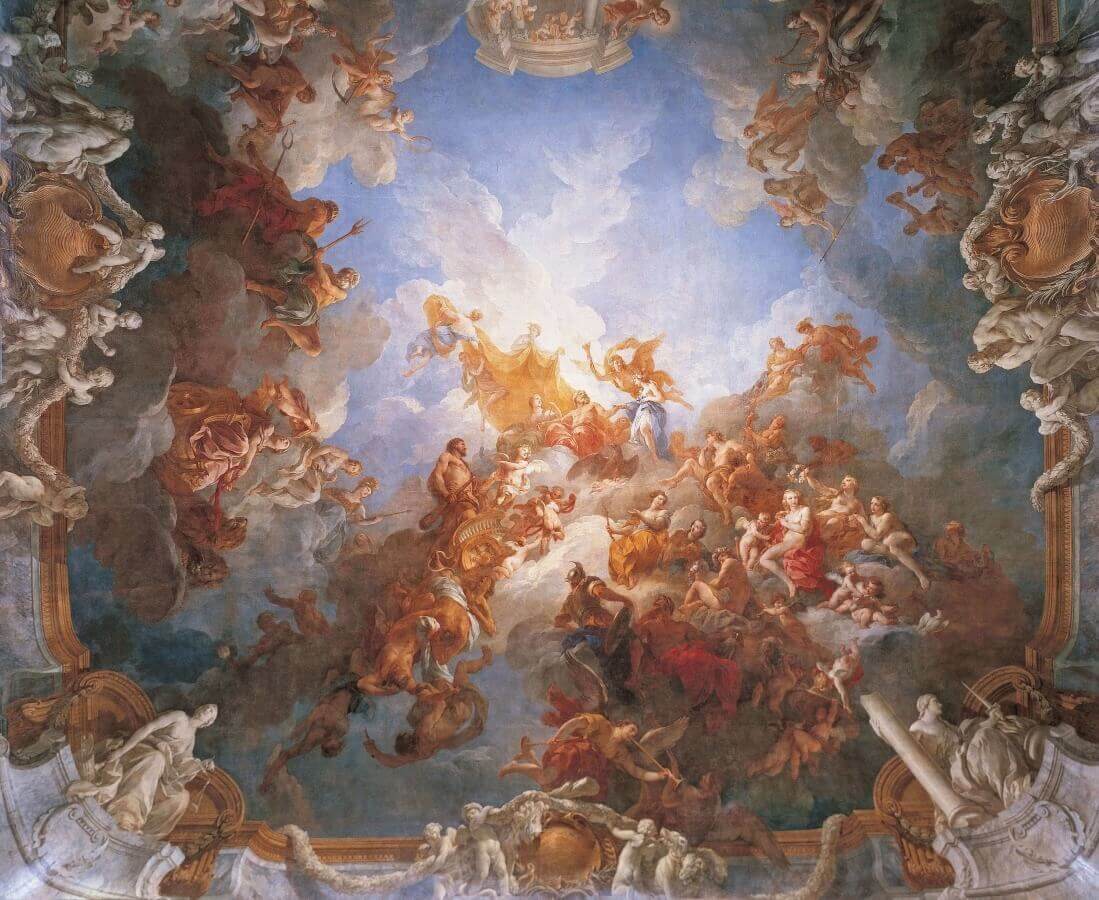
Ironically, after 6 months in 1737, François Lemoyne committed suicide in Paris. The reason for his death is speculated to be due to excess of work, the demise of his wife, temperamental instability, and frustration at his inability to attain artistic perfection.
Other interesting rooms which are part of the State Apartments that you can have a look at are The Hall Of Plenty, The Salon of Venus, The Diana Room, The Mars Room, The Mercury Room and The Apollo Room.
The Royal Chapel
Construction was begun by Hardouin-Mansart in 1699 and was completed by his assistant, de Corte. Construction of the Royal Chapel was completed in 1710 at the end of the reign of Louis XIV. The building’s overall design, large glass windows, and buttresses were inspired by Gothic architecture. It hosted daily masses as well as royal weddings and baptisms until 1789. Read more about its history and the architecture in this article.
The Royal Opera House
The Royal Opera House is one of the greatest works by the architect Ange-Jacques Gabriel. Inaugurated in 1770 during the reign of Louis XV, it was at the time the largest concert hall in Europe. The architecture is impressive with a splendid interior decoration. Louis XV was very reluctant in constructing the Royal Opera House but with much persuasion by architect Gabriel, a theatre was built.
The Gallery of Great Battles / Galerie des Batailles
The Gallery of Battles is a 120-meter-long gallery occupying the first floor of the South Wing in the Palace of Versailles. Louis-Philippe, King of the French after the French Revolution is to be credited for the creation of this gallery.
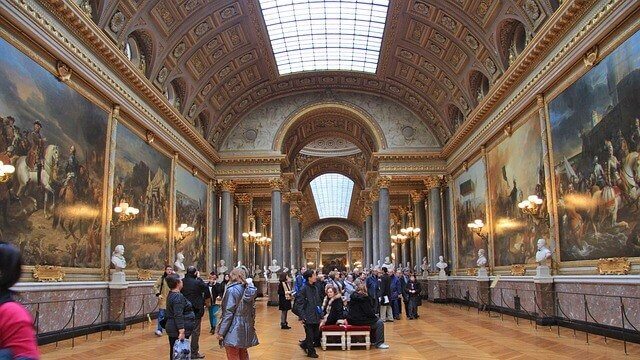
Museum of the History of France / French History Museum
Shortly after becoming King in 1830, Louis-Philippe I decided to transform the Palace of Versailles. Louis-Philippe withdrew its status as a Royal residence and turned the Palace into a museum.
Orangery and The Orange Garden
This is a dedicated quarter in the Royal Palace where oranges and other fruit trees are protected during the winter. Built by the chief architect, Jules Hardouin-Mansart, the construction of the Orangery is such that the temperature is cool enough to not let the plants freeze during winters.
The Orange Garden is easy to locate and it is right beside the Palace, towards the left side when you face the main entrance. You can recognize it by the characteristic four sections of lawn and a circular pool at the center. During summer months you will find orange trees, oleander, pomegranate trees and Eugenia bushes. The Orange Garden is full of these plants during summer and you can find gardeners working here trimming the plants and maintaining the garden.
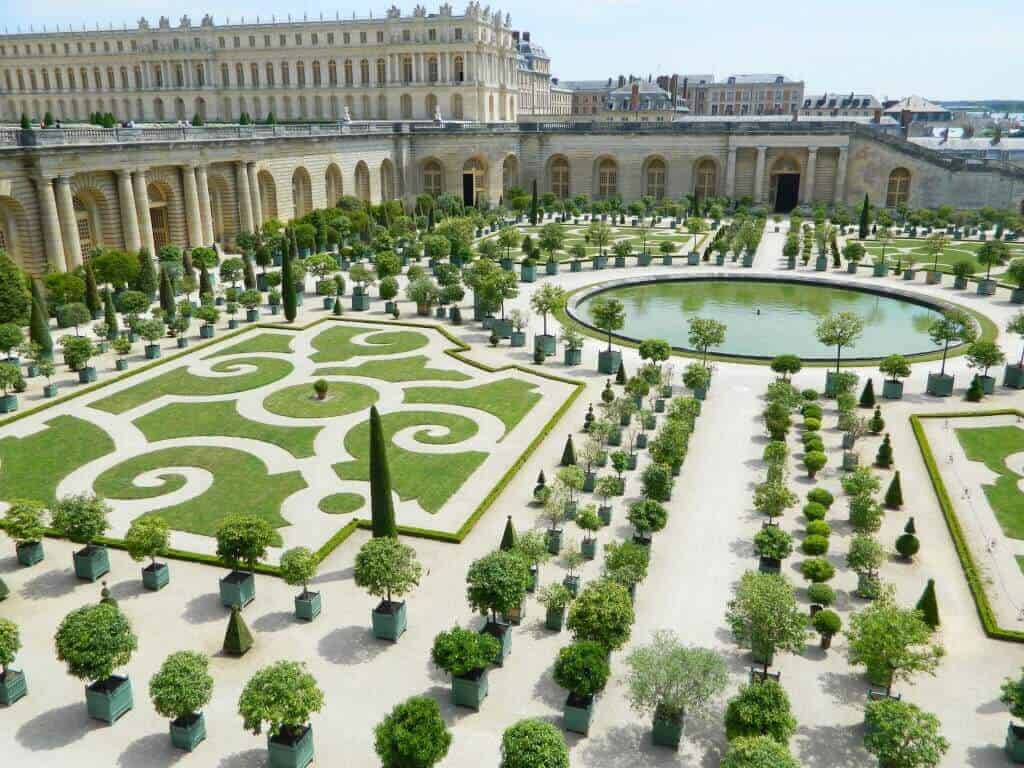
These trees are meticulously moved inside the building during winters and preserved in perfect weather conditions. The Orange gardens look empty with just the lawn during winters.
Travel tip: There are a number of mobile kiosks serving freshly-squeezed orange juice along with the avenues in the gardens during summer and spring.
The Royal Stables
The Great and Small Stables, commissioned by Louis XIV and built by Jules Hardouin-Mansart, constituted the greatest royal construction project for housing horses ever undertaken. Visitors can visit the Gallery of Coaches in the Great Stables and the Sculptures and moldings gallery in the Small Stables.
The Coach Gallery
The Coach Gallery is on the ground floor of the Great Stables. It consists of two vaulted galleries which house an impressive display of coaches. Majestic coaches and small carriages for Marie-Antoinette’s children, sedan chairs, and sleds make up a strange and wonderful collection.
The Gardens of Chateau de Versailles
The Gardens of Chateau de Versailles are its main feature. The fountains and the sculptures are meticulously placed after much thought. This artistic display of the garden should be credited to the chief landscape architect, André Le Nôtre. It was under his guidance and expertise that the Garden which Louis XIV had envisioned was brought to life.
The layout of the garden at Chateau de Versailles
For a very colorful visual tour of the Gardens, watch this interesting video which captures all the nook and corner of this beautiful park.
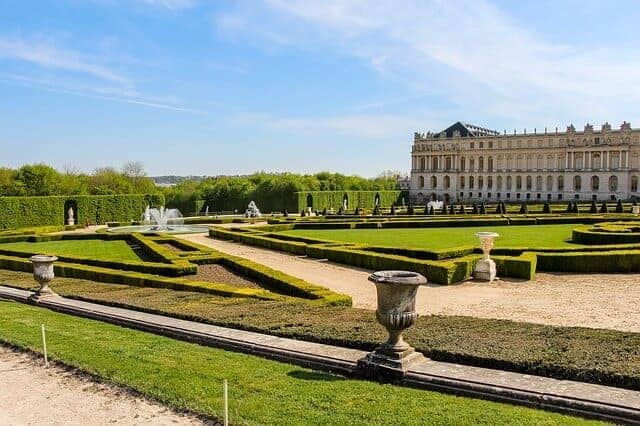
Explore the Garden and the Orangery on foot accompanied by interesting audio commentary using the Versailles Gardens® app. This application is developed exclusively to explore the French formal gardens. You will need an internet connection to operate this application on your phones. You can download this app for Android and iOS.
If you are interested in a personal guided tour of the Gardens, these tours might be of interest to you.
The Garden of Versailles and its history inspired the making of a movie called A Little Chaos. It was directed by Alan Rickman and released in 2015, starring Kate Winslet.
Grand Canal
With a length of 1,500 meters and a width of 62 meters, the Grand Canal was built between 1668 and 1671. Oriented to reflect the sunset, the Grand Canal is 1.6km long and 62m wide. With the line of beech, oak, ash, and wild cherry trees on both the sides, the Grand Canal display a harmonious overview. The Grand Canal was used during royal events as a starting point for fireworks or as a real theater set. The lawn beside the Grand Canal makes for a great picnic spot. You can buy a sandwich from the restaurant have it here enjoying the views of the Garden and the Palace.
Fountains
Fountains are an integral element in the design of the Gardens. The fountains weren’t random arrangements to compliment the layout of the garden but the considerable thought had gone into building each one.
On weekends from late spring to early autumn, the administration of the museum sponsors the Grandes Eaux or the Musical Fountain Night – spectacles during which all the fountains in the gardens are in full play with color and music.
There are more than 30 fountains in the gardens of Versailles, the most famous are: the Neptune fountain, the Apollo fountain, and the Latona fountain. During The Musical Fountain Show, the 50 fountains contribute to the great show of water-jets.
Latona Fountain
The Latona fountain was the result of the desire of Louis XIV. He wished for a fountain in the center of the Garden, which would narrate the story of the childhood of Apollo, the Sun God.
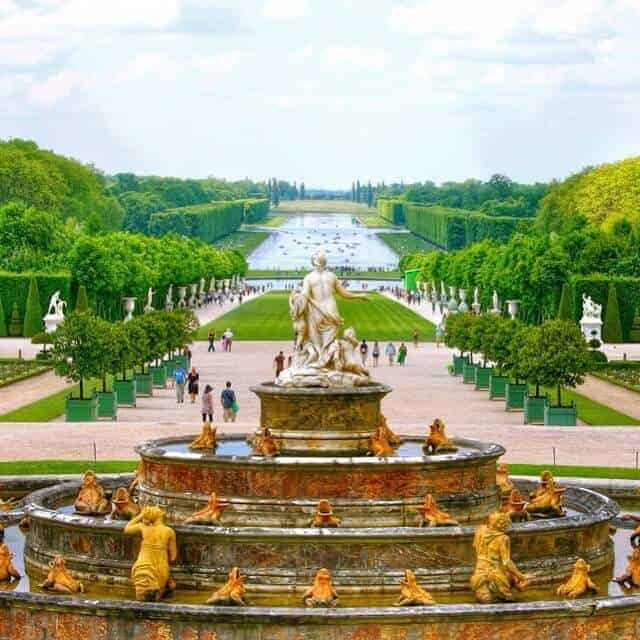
There is an interesting interpretation of the Latona Fountain. Read about the Legend of Latona here, to understand the correlation between King Louis XIV’s childhood and that of Latona’s children Apollo and Diana.
Watch this video to understand the history of the elegant looking Latona Fountain facing westwards, placed between the Palace and the Grand Canal.
Apollo Fountain / Bassin d’Apollo
At the beginning of the Grand Canal in the East-West perspective of the Gardens in the Palace of Versailles is the Apollo Fountain. It features the god bursting forth from the water riding a horse-drawn chariot in anticipation of his daily flight above the earth.
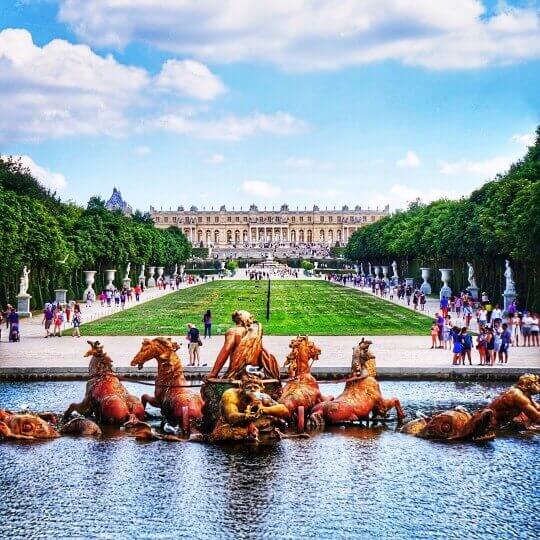
Neptune Fountain
The Neptune Fountain currently has 99 jets, constituting an extraordinary hydraulic system. The Neptune fountain presents 150 different water effects during this show!
Read this guide to know about all the activities in the Garden, like The Musical Fountain Show, The Musical Gardens, The Fountains Night Show and The Royal Serenade and the calendar of events. This guide will help you buy the tickets according to your travel needs.
Have a look at the visually delightful Fountain Night Show and the brilliant display of fireworks and pyrotechnics in this video. This video will definitely entice you to buy the Fountains Night Show ticket as the display of fireworks takes you back in time when the Royals used to celebrate occasions in this fashion in the 17th and 18th century.
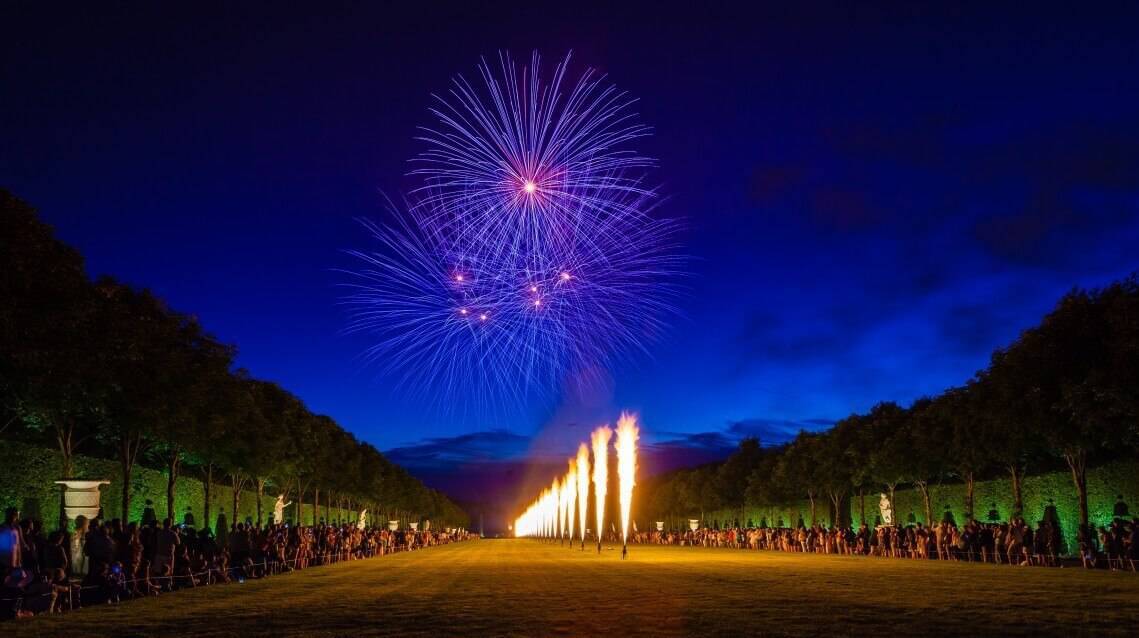
Trianon Palaces
This site includes the Petit Trianon, the Grand Trianon, and the Queen’s Hamlet. There are three ways to reach the Trianon Palaces and Marie-Antoinette’s Estate from the Palace:
By foot through the gardens (around 30 minutes).
With the Little Train: from the Palace stop (North Terrace in the Gardens) to the Grand Trianon or Petit Trianon stop (around 20 minutes / Admission price: €7.50; reduced admission: €5.80 and to only come back to the Palace: €4).
From the Water parterre by renting electric vehicles (€32 per hour).
The layout of the Trianon Palaces
The Grand Trianon was originally built as a retreat for Louis XIV for the King’s relaxation during hot summers. It was surrounded by flower beds and decorated entirely with blue and white porcelain, in imitation of the Chinese style.
Louis XVI gave his wife Marie Antoinette the Petit Trianon in 1774, who made extensive changes to the interiors and added a theatre, the Théâtre de la Reine. Marie Antoinette also totally transformed the arboretum planted during the reign of Louis XV into what became known as the Hameau de la Reine.
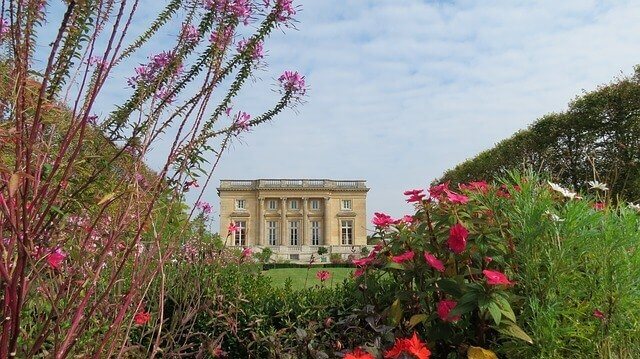
Read about Marie Antoinette’s early life as a princess in Austria, living as a Queen in Versailles, the criticism she faced and her fall in stature due to her extravagant lifestyle and her eventual demise when she was executed in this very well-written article.
The Queen’s Hamlet / Hameau de la Reine
Marie-Antoinette tasked Richard Mique, her favored architect, in 1783 to build a whole model village around an artificial lake. The queen actually used the hamlet as a place for relaxing walks or to host small gatherings.
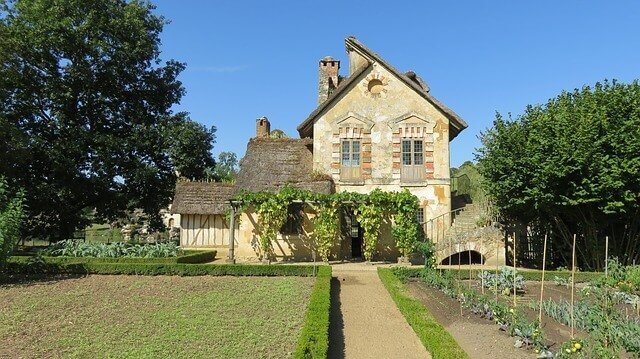
It is a rustic retreat in Palace of Versailles. The layout included a farmhouse, a dairy, a dovecote, a boudoir, a barn, a mill and a tower in the form of a lighthouse. In spite of its idyllic appearance, the hamlet was a real farm, fully managed by a farmer appointed by the Queen, with its vineyards, fields, orchards and vegetable gardens producing fruit and vegetables consumed at the royal table.
Read this travel blog and see what you can expect in this idyllic village setting just a few minutes away from the grand palace.
Chateau de Versailles Facts
Actual building costs for Versailles are debated by modern historians because currency values are uncertain. However, Versailles’ price tag ranges anywhere from two billion USD to a maximum of 50 billion USD.
The cost of construction and the continuous embellishments that followed were so high that the two kings Louis XV and Louis XVI were under debt pressure. This led to unrest among the people which also triggered the 1789 French Revolution.
Eating at Chateau de Versailles
Exploring Chateau de Versailles can be tiring as there is so much to see here. There are many cafes and pastry shops within the Chateau that will help you rest and munch on some great food.
Try the hot chocolate, made traditionally like in the 17th and 18th century at the Angelina Shop. There are amazing pastries and famous French macarons to try at Ladurée, a Parisian pastry shop.
You can enjoy a full course meal at any of the restaurants within the Chateau de Versailles like La Flottille Takeaway, La Petite Venise, Restaurant Angelina, Brasserie de la Girandole, Grand Café D’Orleans, La Flotille and more. You can eat there at the restaurant or pack a sandwich and enjoy your meal on the lawn beside the Grand Canal with fantastic views of the Palace.
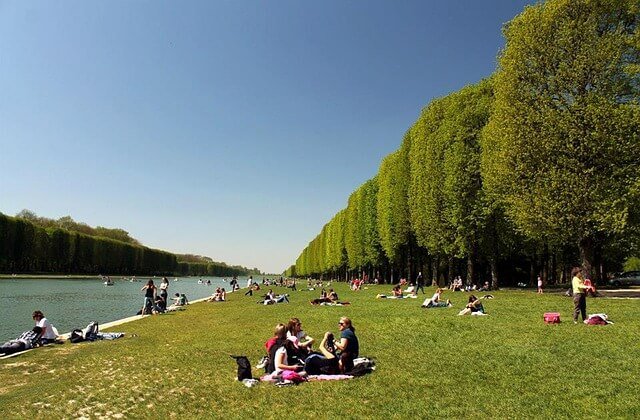
Internet at the Chateau de Versailles
You can stay connected online with free WiFi that is provided at Palace of Versailles. You can connect to WiFi at the following locations: Main entrance of the Palace; Entrance of the gardens at the South Parterre; Entrance of the Petit Trianon; Entrance of the Grand Trianon and Entrance of the Gallery of Coaches.
Travel within the Chateau de Versailles
If you love walking, enjoying a stroll in the beautiful Gardens to explore the Palace, Grand Canal, and the Trianons is great fun.
You have the choice to cycle to these popular places within the Chateau by renting a bike or you can take a ride on the Little Train, row a boat in the Grand Canal or hire a small electric vehicle if you are in a small group. Find out all the options here.
Take a guided tour of the Palace of Versailles including the Gardens in this fun bicycle tour.*
Shopping for souvenirs at Chateau de Versailles
The famed Chateau de Versailles candle is an exclusive range of unique scented candles launched by The Palace of Versailles. There are many fragrances inspired by the scent from various quarters of the Palace.
There is Trianon scented candle, Royal Chapel scented candles, Hall of Mirrors inspired scented candles, Queen’s apartments scented candles and more are available for purchase. You can buy them at the Souvenir shop at the premises of the Palace. You can have a look at the collection here.
You can buy Versailles goodies in any of the souvenir shops within the Palace complex like The Gardens Shop, Estate Shops and at The King’s Medal Cabinet.
Where to stay near Chateau de Versailles?
Versailles is a year-round tourist destination, so there are a number of hotels to stay at.
Hotel de Clangy, Hôtel du Cheval Rouge, Les Versailles B&B, Palace Quartier St Louis, Novotel Château de Versailles are few hotels with good ratings on Booking.com. The prices range between 6000 – 10000 INR per night (90 – 150 USD).
If you buy the Passport entry ticket to visit the Versailles, there are some discounts that can be availed to stay at a select few hotels. Please find out more on the Chateau de Versailles website here.
This brings us to the end of this detailed guide to explore the Chateau de Versailles. Today Versailles reflects its past: that of ancient monarchy and a seat of power and that of a 19th-century museum.
We hope that you enjoyed reading our detailed guide to visiting the Chateau of Versailles. We have shared all the relevant information needed to visit this grand monument. As suggested, book your entry tickets online in advance to enjoy a hassle-free experience.
Do write to us, in case you have any questions and we at Talk Travel are happy to help. If you need any help in building a travel itinerary or you have any other query, download our free TalkTravel App. It is available for download on your Android or iOS device. You can download the TalkTravel App for free and reach out to the local expert without any additional cost. You are free to ask any doubt before or during your travel and our local expert will be ready to assist you.
We wish you a safe and happy travel!
Are you traveling around France? You might want to look at the other guides and posts we have written for France, to make your travel more easy and enjoyable.
*We do not promote any brands or businesses on our platform. We only suggest experiences which are popular keeping in mind the best intentions of our travelers.
https://www.youtube.com/watch?v=tmoTpYdrm9s

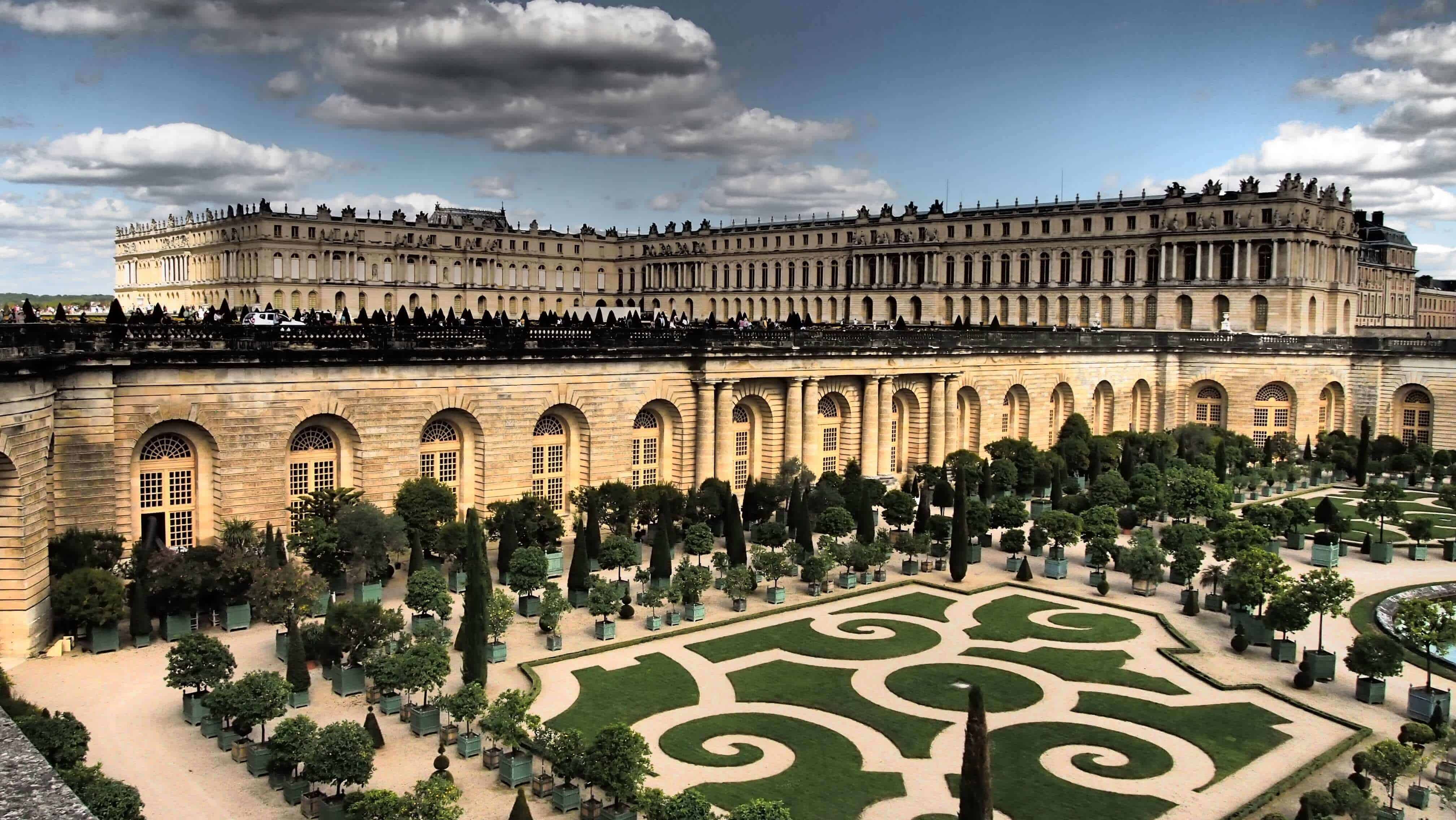
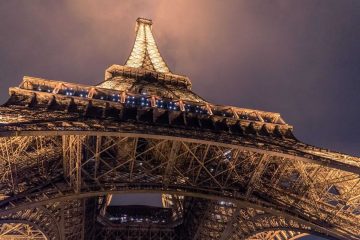
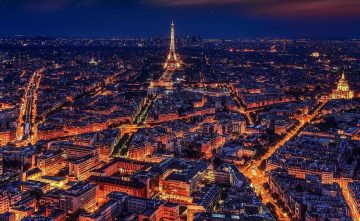
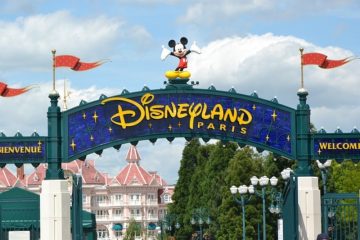
Pingback: Day trips from Paris
Pingback: Movies that take place in Paris, the City of Lights - talktravelapp.com